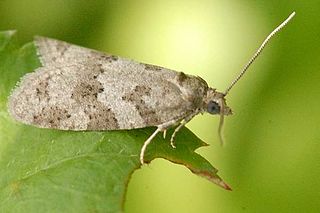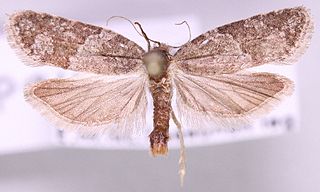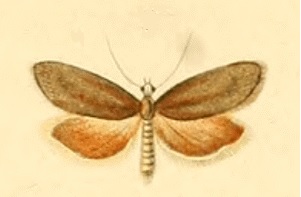
Cnephasia communana is a moth of the family Tortricidae. It is found in Europe.

Cnephasia stephensiana, the grey tortrix, is a moth of the family Tortricidae. It is found in the Palearctic realm, and has also been recorded from Canada.

Cnephasia incertana, the light grey tortrix, is a moth of the family Tortricidae. It is found all over Europe.
Transtillaspis setata is a species of moth of the family Tortricidae. It is found in Venezuela.

Cnephasia pasiuana, the meadow shade, is a moth of the family Tortricidae. It was described by Jacob Hübner in 1799. It is found in almost all of Europe. The habitat consists of rough pastures, fens and marshy areas.

Cnephasia longana, the omnivorous leaftier moth, long-winged shade or strawberry fruitworm, is a moth of the family Tortricidae. It was described by Adrian Hardy Haworth in 1811. It is native to western Europe. It is an introduced species in western North America. The species has also been reported from north-western Africa and Asia. The habitat consists of downland and rough ground.

Phalonidia affinitana, the large saltmarsh conch or large saltmarsh bell, is a species of moth of the family Tortricidae, the subfamily Tortricinae, and the tribe Cochylini. It is found in China, Japan, Korea, Russia and most of Europe. Its habitat consists of salt marshes.

Cnephasia cupressivorana is a species of moth of the family Tortricidae. It is found on Corsica, Sardinia, Sicily and in Belgium, France, Spain, Italy, Switzerland, Austria, Croatia, Slovenia, Albania, Romania, North Macedonia, Greece, Asia Minor and Kyrgyzstan.
Taiteccopsis davisorum is a species of moth of the family Tortricidae. It is found in Nigeria.

Cnephasia abrasana is a species of moth of the family Tortricidae. It is found in Europe, where it has been recorded from Albania, Bosnia and Herzegovina, Bulgaria, Romania, North Macedonia, Greece, Slovakia, Slovenia, Austria, Italy and Lithuania and on Corsica. It is also found in the Near East.
Cnephasia alfacarana is a species of moth of the family Tortricidae. It is found in Portugal and Spain.
Cnephasia alticola is a species of moth of the family Tortricidae. It is found in the Russian Far East.
Cnephasia amseli is a species of moth of the family Tortricidae. It is found on Sicily and Malta and in North Africa, where it has been recorded from Tunisia.
Cnephasia bizensis is a species of moth of the family Tortricidae. It is found in France, Italy and possibly Spain.

Cnephasia chrysantheana is a species of moth of the family Tortricidae. It is found in the Near East, Spain, France, Italy, Austria, the Czech Republic, Slovakia, Slovenia, Hungary, Romania, Ukraine and on Sicily and Sardinia.

Cnephasia conspersana is a species of moth of the family Tortricidae. It is found in Ireland, Great Britain, France, Italy, Portugal, Spain and North Africa. The habitat consists of coastal chalk downlands and heathlands.
Cnephasia heringi is a species of moth of the family Tortricidae. It is found in Bulgaria, Greece, North Macedonia, Russia and Turkey.
Cnephasia delnoyana is a species of moth of the family Tortricidae. It is found in Portugal and Spain, where it has been recorded from Algarve and Almeria.
Cnephasia disforma is a species of moth of the family Tortricidae. It is found on Crete.
Cnephasia nesiotica is a species of moth of the family Tortricidae. It is found on the Canary Islands.









